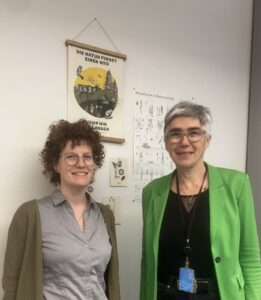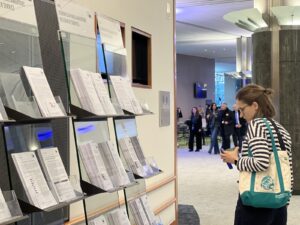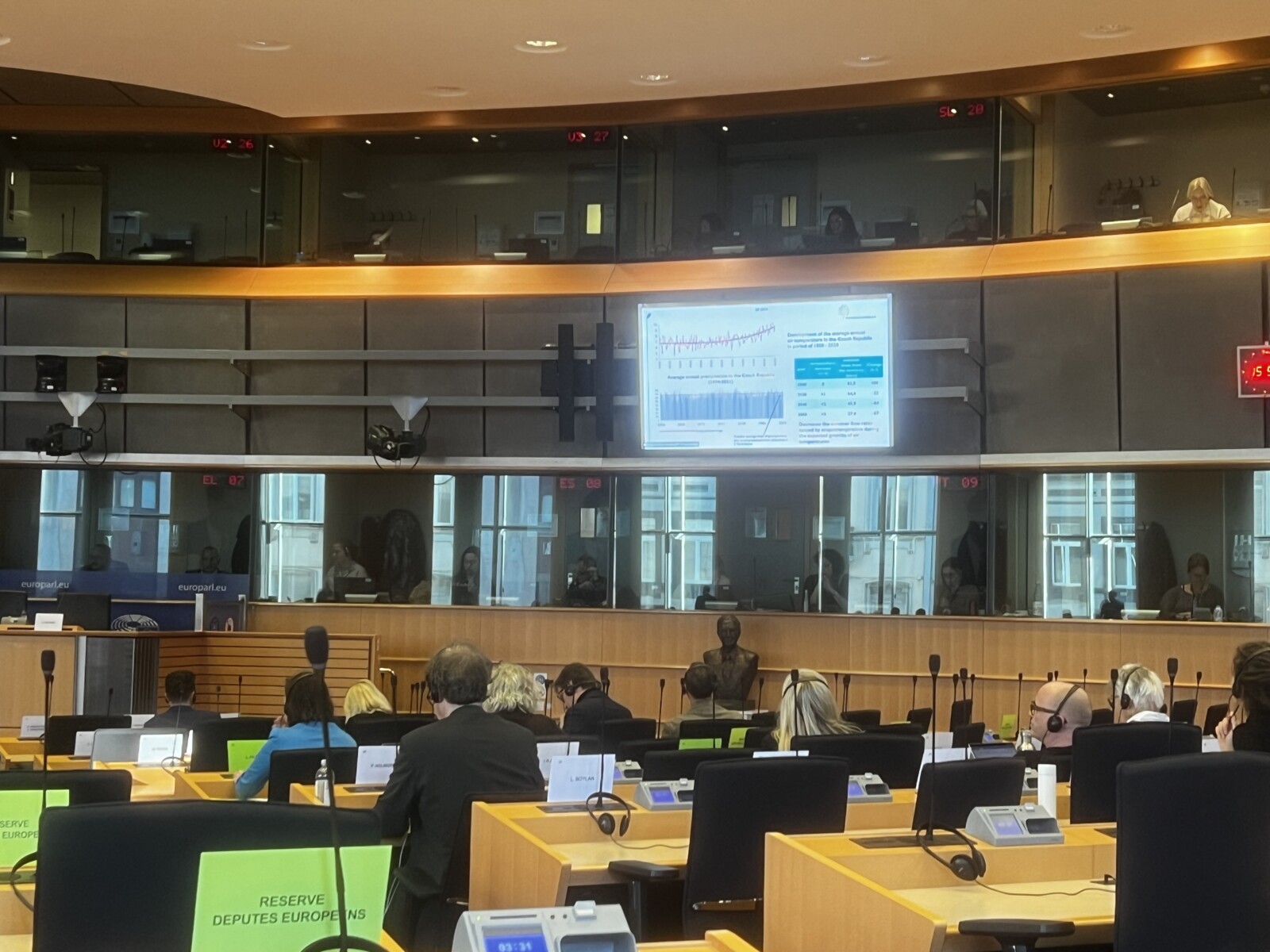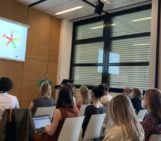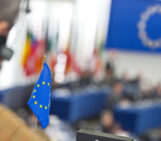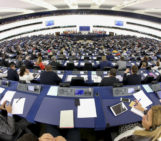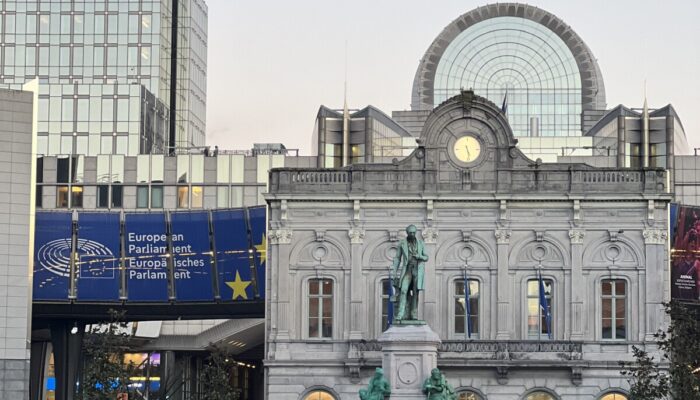
As the selected scientist in the EGU’s 2024 Science-Policy Pairing Scheme, I had the opportunity to experience life inside the European Parliament for a week with the support of Member of the European Parliament (MEP) Jutta Paulus and her team, who are part of the Group of the Greens/European Free Alliance. A week is short, but in these few days, I gained deeper insights into the inner workings of the European Parliament than I had in over a decade of living near the EU institutions.
My journey in Brussels began in 2011 when I moved there to follow my heart and study Geography. Then I continued doing research on climate change impacts on Belgian orchards and worked for a regional agricultural ministry. Still, I was never close to the so-called ‘EU Bubble’: the ‘expats’ working for or around European Institutions. Therefore, my understanding of European policymaking remained rather limited.
For us as scientists, as well as citizens, the European Parliament is the most accessible of the EU institutions, with much of its work conducted in the public eye. Throughout this week, I repeatedly witnessed how the public interest in a topic and how it lends itself well for a social media campaign plays a role for topic choices and reporting prioritisation. The parliament also is the only institution with elected members, so watching its debates is witnessing ‘democracy in action’—a phrase prominently displayed on the Parliament’s main building.
The current political landscape, marked by a strong presence of conservative and right-wing parties compared with the Parliament’s 2019-2024 configuration, casts a challenging outlook on environmental policies, including nature conservation, forest monitoring, and climate change mitigation. From the perspective of the Green Party, the focus is now on safeguarding past achievements!
One of the most obvious takeaways from my time with Jutta and her team was the relentless pace in which everything seemed to happen —meetings flow into one another, alternating between internal consultations, stakeholder engagements, technical discussions on legislative amendments, hearings, and public workshops. Amidst this, staff navigated a constant stream of emails, administrative tasks, and procedural adjustments, all while integrating new colleagues and rules at the start of the legislative term. Even finding time for a meal break turned out to be a logistical challenge!
For a newcomer, the physical layout of the Parliament added to the complexity. Meetings were spread across different buildings, making transitions between sessions more time-consuming than expected. Furthermore, Brussels’ unpredictable rain and uneven pedestrian pathways turn them into an obstacle course of puddles and traffic! As a result, many staff members shield their business attire beneath neon raincoats, equipped with waterproof bike bags and helmets.
Initially, I was intrigued by the Parliament’s dress code—its mix of formal wear and subtle political statements. Over time, I started identifying party affiliations through clothing choices, though not always with certainty. However, I am here not as an observer of fashion, but as a scientist, which brings me to two key questions: What role does science play in the daily workings of the European Parliament? And how can scientists effectively bring their expertise to the desks of Members of the European Parliament?
Science & Policy in the European Parliament: Bridging the Gap
Throughout this week, the words science, evidence, study, monitoring, and reports were echoed frequently in parliamentary discussions. However, are policy decisions truly based on facts, or do they hinge on the ability to argue convincingly—whether by representing a larger political fraction, having closer ties to the rapporteur, or simply possessing greater experience in the legislative process? The reality of democracy in action often involves compromises, some of which may appear arbitrary—such as defining the threshold for what qualifies as ‘small production’ or determining reasonable time intervals between regulatory controls.
On the other hand, significant efforts and resources are invested in bringing scientific insights to Members of the European Parliament (MEPs). By the main café, where the staff holds countless ‘coffee meetings’, there are big shelves with scientific studies, conducted by the European Parliamentary Research Service (EPRS) that provides comprehensive research and analytical support to the MEPs. There are also many hearings that bring in external expertise and knowledge for high level discussions.
Public hearings with scientists are a vital part of Committee Meetings
During my week in the Parliament, I had the opportunity to attend an ENVI (Environment, Public Health, and Food Safety) Committee meeting that also included a hearing. These hearings are public and livestreamed, and my first recommendation is to follow one online to gain an understanding of how topics are debated and addressed.
The session I attended was focused on the development of a comprehensive Water Resilience Strategy. It included inputs from scientists and representatives from the European Environmental Agency, NGOs, and regional governments.The speakers were invited to present by the legislation’s rapporteur, the selected MEP who is responsible for drafting a report that is then used by the Committee during the legislative process. Rapporteurs are therefore not neutral but from one of the political groups and can set the direction of the inputs. The session itself reminded me of a scientific conference. The speakers present their points with the help of PowerPoint slides, and at the end, questions/statements from the audience are collected. One striking observation was that, even from the front rows where MEPs sit, most presentation slides were barely visible and mostly overloaded with information. Capturing the attention of policymakers is even more challenging than engaging an audience of fellow scientists, making it essential for presentations to be concise, impactful, and memorable!
Two interventions from the hearing stood out to me. The first was from an NGO, which effectively set the scene by asking the audience to imagine themselves in a specific scenario. It was delivered in a clear voice, with structured arguments and uncluttered slides, ensuring the message was well received. Another, seemingly effective tactic was used during an intervention on dams. The speaker was assertive and rather repetitive, which risked being boring, however the key facts resonated and stuck with me after the hearing concluded.
Stakeholders and MEPs get together in thematic workshops as preparation for trilogue negotiations
Another interesting session was a lunchtime workshop on microplastic spills in coastal waters. The workshop aimed to ‘bringing together policymakers, industry leaders, NGOs, and experts’. Mayors of affected towns were invited along with other stakeholders and MEP’s to share their perspectives, suggested solutions and positions. While a lot of time and resources are invested in making these meetings happen, I was told that the impact of these sessions is relatively limited. Despite this, I was happy to hear some arguments from these discussions made there in a technical discussion later on. Ultimately, researchers need to remember that MEPs receive a lot of input every day and our outreach activities may just be a drop in the ocean of inputs that stream into the inboxes of MEPs every day. If we scientists want to inform the policymakers about recent studies, we are competing with that stream. While much of the information that we provide won’t make it into the legislative discussion, some well-communicated aspects occasionally do and it is still worth trying! So don’t be afraid to reach out and start engaging!
Communicating Science to Policymakers: Timing and Strategy Matter
Now, imagine yourself as an MEP. Over the course of the year, you will engage with dozens of topics—some within your area of expertise, others far beyond your comfort zone. This week alone, you are expected to attend events covering four distinct policy issues. When and how would you prefer to receive information to prepare for these discussions?
Tips for Getting Your Research Noticed in the Policy Process
If you want your research to inform policymaking, consider the following steps:
- Timing matters. Ideally, policymakers need to receive relevant information just a bit ahead of time, allowing them to contextualise what they will hear and contribute meaningfully. Therefore, it is good practice to monitor the agendas of committees relevant to your topic, likely ENVI.
- Target the right MEPs: Identify those with relevant expertise, committee roles, and a demonstrated openness to scientific input. You can find members of the committees online.
- Engage their assistants: Find the MEP’s assistants on their official webpage and reach out to them directly at firstname.lastname@europarl.europa.eu. During my time in the Parliament, they were heavily loaded with tasks but also very committed to their role and grateful for useful input!
- Structure your communication effectively: Clearly state your key message in the body of the email, with clear policy recommendations (what should be done?), attach more detailed documentation, and—if applicable—include the original study.
- Follow up: Don’t hesitate to call the assistants and confirm that your email was received.
In conclusion, I would say that the European Parliament is a great place to start learning about and interacting with policymaking. The pairing scheme was very valuable for me and a great initiative by the EGU. I am also very grateful to Jutta and Léonie for showing me around and introducing me to the Parliament’s work.
From the perspective of a scientist with a relatively narrow scope of expertise, it was really impressive to see the variety of topics they work on, but also the constant flood of information they are exposed to. Bringing scientific insights into policymaking therefore requires persistence and strategic communication. By understanding how decisions are made and tailoring your approach accordingly, you can increase the chances that your research will be considered in shaping European policies.


